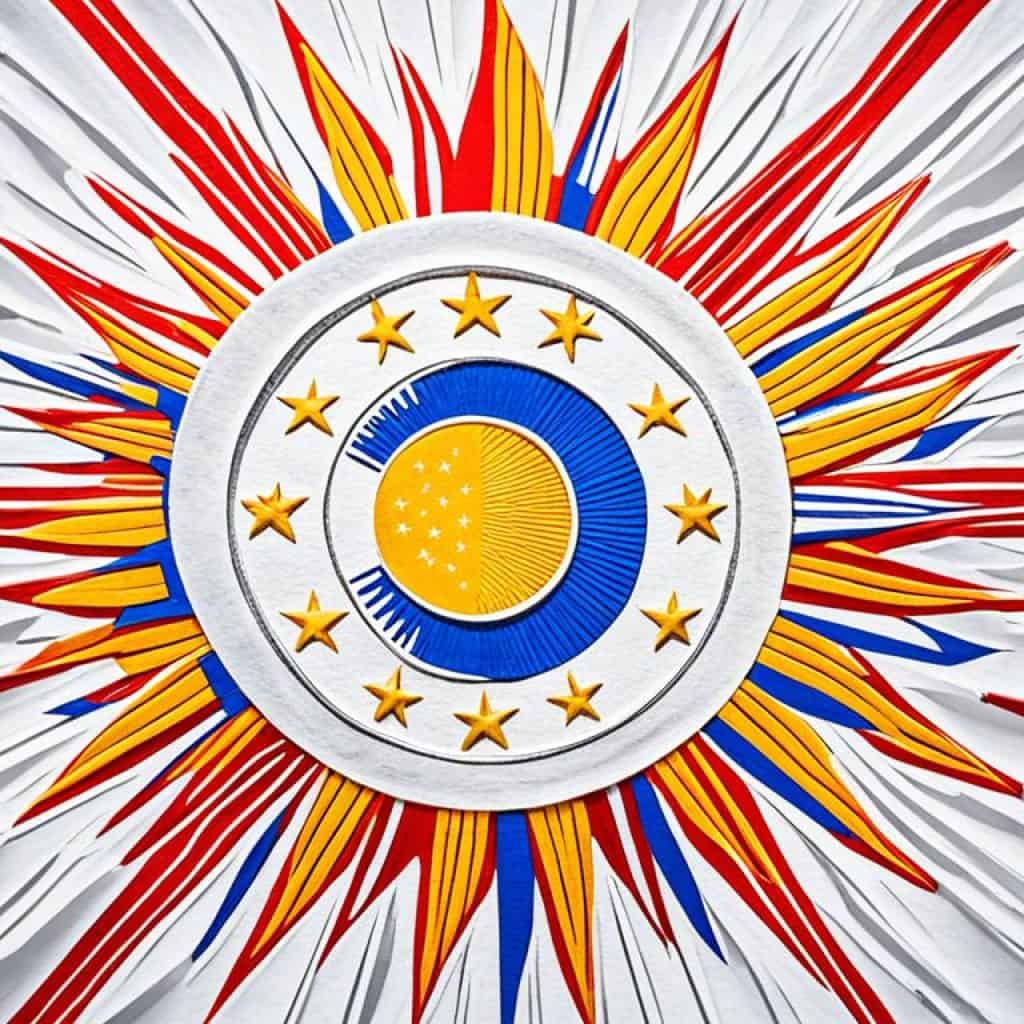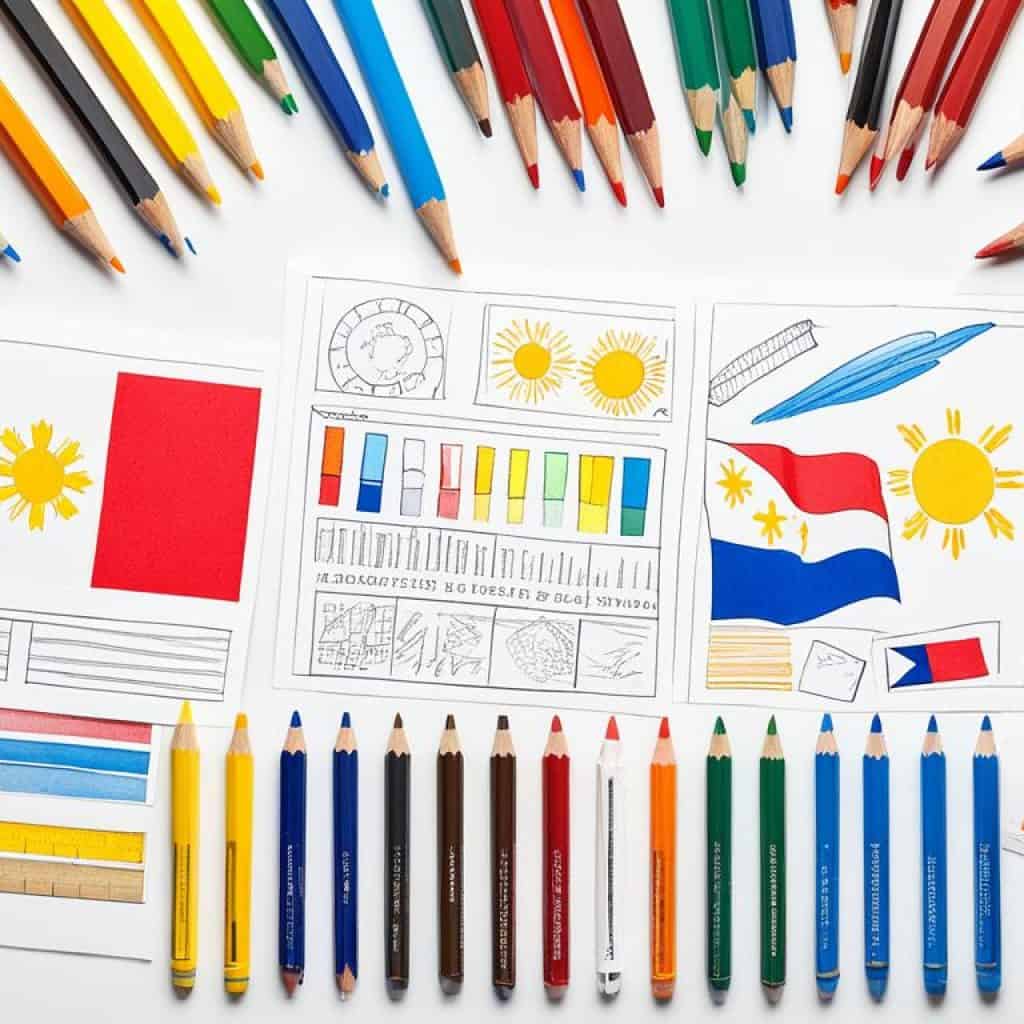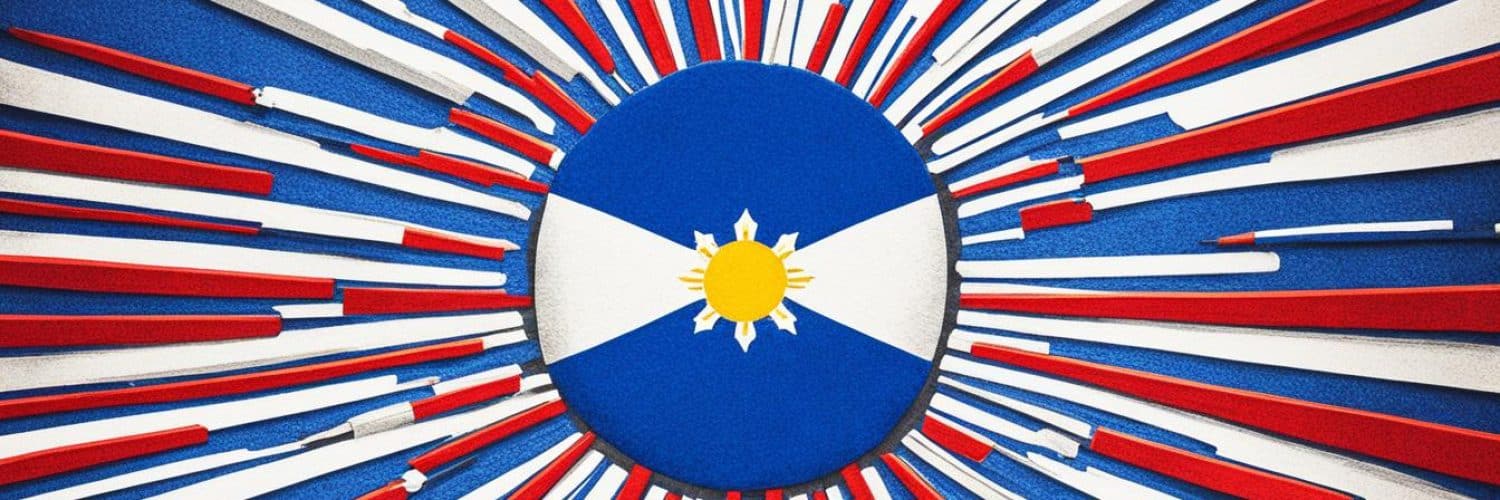Have you ever wondered how to draw the flag of the Philippines? Maybe you think it’s too complex or challenging? Well, prepare to be amazed because we have a step-by-step guide that will make it easy for you to create your own stunning representation of the flag. Are you ready to unleash your artistic skills and dive into the world of Philippine flag drawing?
Key Takeaways:
- Discover the design and symbolism of the flag
- Learn about the historical significance of the flag
- Explore the colors and elements of the flag
- Master the step-by-step process of drawing the flag
- Get tips and techniques for creating a simple yet beautiful illustration
Design of the Flag
The design of the Philippine flag is rich in symbolism, representing the values and aspirations of the Filipino people. The flag consists of a blue stripe and a red stripe, with a white equilateral triangle at the hoist. The blue stripe symbolizes peace, truth, and justice, while the red stripe represents patriotism and valor. The white triangle signifies courage, heroism, and bravery.
The golden-yellow sun with eight rays at the center of the flag embodies unity, freedom, people’s democracy, and sovereignty. It represents the bright future of the Philippines and its people. The three golden-yellow stars at the corners of the triangle symbolize the three main island groups of Luzon, Visayas, and Mindanao.
The proportions of the flag are significant, with its length being twice its width. Each element of the flag has specific measurements and proportions that must be followed to ensure accuracy and authenticity in any Filipino flag artwork. When creating a sketch or artwork of the Philippine flag, it is essential to pay attention to these details to capture its true essence.
Design Elements:
| Design Element | Symbolism |
|---|---|
| Blue Stripe | Peace, truth, and justice |
| Red Stripe | Patriotism and valor |
| White Triangle | Courage, heroism, and bravery |
| Golden-Yellow Sun | Unity, freedom, people’s democracy, and sovereignty |
| Three Golden-Yellow Stars | The main island groups of Luzon, Visayas, and Mindanao |
Understanding the design elements and their meanings is crucial when sketching or creating artwork of the Philippine flag. By incorporating these symbolic elements, you can accurately depict the essence and significance of the flag in your Filipino flag artwork.
Historical Significance of the Flag
The flag of the Philippines holds great historical significance as a symbol of the nation’s fight for freedom and independence. Originally designed by Emilio Aguinaldo, the leader of the Philippine Revolution, the flag was first unfurled during the declaration of independence on June 12, 1898. Since then, it has represented the Filipino people’s unwavering spirit and determination.
Over the years, the design of the flag has undergone minor modifications, mainly in the shade of blue and red fields and the intricacies of the sun. These changes reflect the evolving history and aspirations of the Filipino nation.
The flag’s evolution is a testament to the resilience and endurance of the Filipino people. It serves as a reminder of the struggles and sacrifices made to achieve independence and serves as a beacon of hope for future generations.
Symbolism of the Flag
The flag of the Philippines carries profound symbolism through its design and elements. Each component embodies the values and aspirations of the Filipino people, reflecting their history, culture, and identity.
The equilateral triangle at the hoist represents three fundamental principles: liberty, equality, and fraternity. It symbolizes the importance of these ideals in the Filipino society and their commitment to upholding them.

“The golden-yellow sun with eight rays represents the first eight provinces that led the revolution against the Spanish.”
The golden-yellow sun, with its eight primary rays, holds a crucial significance in the flag. It signifies the first eight provinces that played a pivotal role in the Philippine Revolution against Spanish colonization. The sun embodies unity, freedom, people’s democracy, and sovereignty, serving as a constant reminder of the country’s hard-fought independence.
The three stars, placed at the vertices of the triangle, hold great meaning as well. They represent the three main island groups of the Philippines: Luzon, Visayas, and Mindanao. Together, these stars symbolize the unity and shared identity of the Filipino people across the different regions of the country.
The blue field on the flag stands for peace, truth, and justice. It represents the desire for a peaceful society where truth and justice prevail, enabling the growth and well-being of the Filipino nation.
On the other hand, the red field symbolizes patriotism and valor. It embodies the unwavering patriotism of the Filipino people who have demonstrated immense bravery in defending their homeland throughout history.
Collectively, the Philippine flag serves as a powerful testament to the values, dreams, and resilience of the Filipino people. It stands as a proud symbol of their heritage and a constant reminder of the shared history that binds them together.
Drawing the Flag Step-by-Step
To recreate the flag of the Philippines, follow these step-by-step instructions. With attention to detail and careful measurements, you can capture the essence and symbolism of the flag.
1. Begin by drawing a rectangle. Divide the rectangle into two equal bands vertically, with the upper band colored blue and the lower band colored red. This represents the peace, truth, justice, patriotism, and valor that the flag signifies.
2. On the hoist (left) side of the flag, draw a white equilateral triangle. The triangle symbolizes courage, heroism, and bravery.
3. Inside the triangle, draw a golden-yellow sun with eight primary rays. The sun represents unity, freedom, people’s democracy, and sovereignty. The rays emanating from the sun symbolize the first eight provinces that led the revolution against Spanish rule.
4. At each vertex of the triangle, draw a five-pointed golden-yellow star. These stars represent the three main island groups of the Philippines: Luzon, Visayas, and Mindanao.
5. Pay attention to the proportions and measurements of each element. This will ensure an accurate representation of the flag’s design.
6. To bring the flag to life, use shading and coloring techniques. Use a vibrant blue for the upper band, a rich red for the lower band, a bright white for the triangle, and a warm golden-yellow for the sun and stars.
Note: Take your time with each step, and don’t be afraid to make adjustments along the way. The key to drawing the flag of the Philippines is to capture its symbolism and represent it with precision.
By following these step-by-step instructions, you can create a beautiful and accurate drawing of the flag of the Philippines.
Tips for a Simple Philippines Flag Illustration
If you want to create a simple illustration of the Philippine flag, focus on the key elements. Use basic shapes and lines to represent the blue and red bands, the white triangle, and the golden-yellow sun and stars. Simplify the details while maintaining the overall design and symbolism.
Begin with a rectangle and divide it into two equal bands of blue and red. Use a ruler or straight edge to ensure clean lines. Place a white equilateral triangle at the hoist side of the flag. The triangle should be proportional to the flag’s dimensions.
Now, let’s tackle the golden-yellow sun. It has eight primary rays that radiate outwards. Use straight lines to create the rays and make sure they are evenly spaced. At the vertices of the white triangle, add three five-pointed golden-yellow stars. Again, keep the proportions in mind, and place the stars in a way that represents the three main island groups of Luzon, Visayas, and Mindanao.
To bring your illustration to life, consider using shading and coloring techniques. Use lighter shades of blue and red to indicate highlights, and darker shades to create shadows. Add depth and dimension by applying gradients or subtle variations in color.
Remember, simplicity is key when creating a simple illustration of the Philippine flag. Focus on the essential elements and avoid getting caught up in intricate details. The goal is to capture the flag’s symbolism and convey its meaning in a visually appealing way.
If you’re new to flag drawing, it’s always helpful to practice with pencil sketches before moving on to digital or colored illustrations. This allows you to refine your technique and experiment with different styles. Take your time and enjoy the process of bringing the Philippine flag to life through your illustration.
| Tip | Description |
|---|---|
| Start with basic shapes | Use rectangles, triangles, and straight lines to form the flag’s elements. |
| Focus on proportions | Ensure each element is properly sized and positioned within the flag. |
| Simplify details | Avoid intricate designs and focus on capturing the essence of the flag. |
| Use shading and coloring | Add depth and dimension to your illustration with shading and color techniques. |
| Practice pencil sketches | Refine your technique by practicing with pencil sketches before moving to digital or colored illustrations. |
Materials and Tools for Flag Drawing
To create a flag drawing of the Philippines, you will need a range of materials and tools. Here are the essentials you should gather:
Drawing Materials:
- Paper or sketchbook
- Pencils or colored pencils
- Erasers
- Ruler
- Sharpener
Note: If you prefer digital artwork, you can use drawing software and a graphic tablet instead of traditional materials.
Additional Tools:
- Compass or stencil (for precise geometric shapes like the equilateral triangle)
By experimenting with different materials and tools, you can find the ones that work best for you and achieve the desired results in your flag artwork.

Table of Materials and Tools
| Materials | Tools |
|---|---|
| Paper or sketchbook | Pencils or colored pencils |
| Erasers | Ruler |
| Sharpener | Compass or stencil |
| – | Drawing software |
| – | Graphic tablet |
Color Palette for the Flag
The colors used in the flag of the Philippines are specific and have been standardized. To accurately depict the flag’s colors, it is important to understand their exact shades. The blue in the flag is a shade of royal blue, symbolizing peace, truth, and justice. The red is a shade of crimson red, representing patriotism and valor. The white is a pure and bright white, symbolizing courage, heroism, and bravery. The golden-yellow is a vibrant and warm hue, representing unity, freedom, people’s democracy, and sovereignty.
When recreating the flag, it is advisable to use color swatches or references to ensure accuracy. Pay attention to the color values and saturation to achieve a realistic representation of the flag. By using the correct color palette, your flag drawing will capture the essence and symbolism of the Philippines’ national flag.
Adding Details and Texture to the Flag
To create a visually captivating Philippine flag drawing, it’s essential to focus on adding intricate details and texture. This will bring depth and dimension to your artwork and make it more realistic. By paying attention to shading, highlights, and various texture techniques, you can elevate your flag drawing to the next level.
Here are some tips to help you add details and texture:
- Shading and Highlights: Use shading techniques to create shadows and highlights on different parts of the flag. This will give a sense of depth and make the elements stand out. Experiment with different levels of shading to achieve the desired effect.
- Cross-Hatching and Stippling: Cross-hatching and stippling are effective techniques for creating texture. Use cross-hatching to produce diagonal lines or strokes that intersect, adding texture to the golden-yellow sun and stars. Stippling involves creating small dots to build up texture and can be used on various parts of the flag.
- Pencil Strokes and Blending: Explore different pencil strokes to add texture and definition to the various elements of the flag. For example, use short, quick strokes for the rays of the sun and smooth, long strokes for the red and blue bands. Blending techniques can be used to create smooth transitions between colors and gradients.
- Reference Images: Study real flags or high-quality reference images to understand how light and shadows interact with the flag’s elements. This will help you accurately recreate textures and enhance the overall realism of your drawing.
Remember to experiment and practice with these techniques to find the ones that work best for your artistic style. Adding details and texture will make your Philippine flag artwork truly impressive and visually engaging.
Adding details and texture to your Philippine flag drawing can make it more visually appealing and realistic. Incorporating shading, cross-hatching, and stippling techniques will enhance the depth and texture of the golden-yellow sun and stars. Experiment with different pencil strokes and blending techniques to achieve the desired effect. By studying reference images, you can accurately recreate the textures found in a real flag. Let your creativity flourish as you bring your Philippine flag artwork to life.
Showcasing Your Flag Drawing
Once you have completed your Philippine flag drawing, it’s time to showcase your artwork to the world. There are various ways to display and share your masterpiece, allowing others to appreciate your talent and creativity. Here are some ideas to inspire you:
- Frame and Hang: Choose a beautiful frame that complements your drawing and proudly hang it on a prominent wall. This not only adds aesthetic value to your space but also serves as a conversation starter.
- Digital Portfolio or Social Media: Create an online portfolio or share your artwork on social media platforms, such as Instagram or Pinterest. These platforms provide a global audience and allow you to connect with fellow artists and enthusiasts.
- Personal Projects or Gifts: Incorporate your flag drawing into personal projects, such as custom-made greeting cards, bookmarks, or stickers. You can also give your artwork as a meaningful and unique gift to friends or family.
- Art Exhibitions and Competitions: Explore opportunities to participate in local art exhibitions or competitions. These events allow you to gain exposure, receive feedback, and potentially win recognition for your talent.
Sharing your artwork with others is a fulfilling experience that encourages creativity and fosters a sense of community. It’s essential to acknowledge and credit the design and symbolism of the Philippine flag when showcasing your drawing, ensuring respect for its cultural significance.
Flag Drawing Tips for Beginners
If you’re a beginner in flag drawing, don’t worry! With some practice and the right techniques, you can create a beautiful representation of the Philippine flag. Here are some tips to help you get started:
Start with the Basics
Begin by familiarizing yourself with the basic shapes and elements of the Philippine flag. Take note of the proportions and measurements to ensure accuracy in your drawing.
Guidelines and References
Use guidelines and reference images to assist you in creating a consistent and balanced composition. These references will help you understand the placement and size of each element of the flag.
Patience and Practice
Remember, drawing takes time and practice. Be patient with yourself and embrace the learning process. Mistakes are a part of improving, so don’t get discouraged. Keep practicing, and you’ll see progress over time.
Experiment with Techniques and Styles
Don’t be afraid to explore different drawing techniques and styles. Experiment with shading, coloring, and linework to find your unique artistic flair. This is an opportunity for you to develop your own creative expression.
By following these tips and dedicating time to practice, you’ll improve your flag drawing skills and create impressive artwork. Enjoy the journey of capturing the beauty and symbolism of the Philippine flag!
Improve your flag drawing skills by getting familiar with the basic shapes and proportions of the Philippine flag. Utilize guidelines and reference images, be patient and practice regularly, and don’t be afraid to experiment with different techniques and styles. Enjoy the process of creating your own unique and beautiful artwork!
Inspiration for Flag Artwork
If you’re looking for creative ideas for Philippine flag drawing, there are various sources you can explore to find inspiration. Studying different artists’ interpretations of the flag and their unique styles can provide valuable insights and ignite your creativity. Additionally, researching historical events and stories related to the flag can deepen your understanding and offer new perspectives for your artwork.
One key source of inspiration is Filipino culture, traditions, and landscapes. Consider incorporating elements from traditional Filipino art forms, such as patterns and motifs, into your flag artwork. Draw inspiration from the vibrant and diverse landscapes of the Philippines, including its stunning beaches, lush greenery, and majestic mountains.
Experimenting with different mediums can also spark your creativity. Try working with watercolors to create soft and delicate textures, or use acrylics for bold and vibrant effects. If you prefer digital art, explore the possibilities offered by digital painting software and graphic tablets.
A visualization of a flag artwork that reflects the beauty and culture of the Philippines.
Remember, when creating flag artwork, let your creativity flow and develop your own unique style and interpretation. Draw inspiration from various sources, but also allow yourself the freedom to explore and experiment. By infusing your artwork with your personal touch, you can create a Philippine flag drawing that is truly one-of-a-kind and captures the spirit of the nation.
Resources for Flag Drawing
To further enhance your flag drawing skills, take advantage of the available resources. These resources can provide valuable guidance and inspiration as you strive to create an accurate and compelling representation of the Philippine flag. Whether you are a beginner or an experienced artist, these references and tutorials can help you refine your technique and improve your overall drawing abilities.
Drawing Tutorials
Look for drawing tutorials specifically focused on the Philippine flag. These tutorials will provide step-by-step instructions on how to draw each element of the flag, from the blue and red bands to the golden-yellow sun and stars. By following these tutorials, you can learn the proper proportions and measurements for each component, helping you create a more accurate representation of the flag.
Reference Images and Photographs
Study reference images and photographs of the flag to gain a better understanding of its details and proportions. Analyze the colors, shapes, and shading used in these images to inform your own drawing. Pay close attention to the placement and size of each element, as well as any intricate details that may be present. By studying reference images, you can improve your ability to capture the flag’s unique design and symbolism.
Art Communities and Workshops
Join art communities or workshops where you can connect with other artists who share your passion for flag drawing. These communities and workshops provide a supportive environment where you can learn from experienced artists, exchange ideas, and receive valuable feedback on your work. Engaging with other artists can inspire new techniques and approaches, helping you expand your artistic repertoire and further develop your flag drawing skills.
Regular Practice and Challenges
Practice regularly and challenge yourself with new techniques and styles. Dedicate time to exploring different drawing methods and experimenting with various artistic mediums. Set goals for yourself and push the boundaries of your creative abilities. The more you practice and challenge yourself, the more you will grow as an artist and improve your flag drawing skills.
| Resources | Description |
|---|---|
| Drawing Tutorials | Step-by-step instructions on drawing the Philippine flag |
| Reference Images and Photographs | Visual references for understanding the flag’s details and proportions |
| Art Communities and Workshops | Networking opportunities and feedback from fellow artists |
| Regular Practice and Challenges | Ongoing improvement through consistent practice and experimentation |
By utilizing these resources, you can enhance your flag drawing skills and create impressive and accurate representations of the Philippine flag. Remember to stay committed to your artistic journey, be open to learning from others, and embrace the joy of creating meaningful and visually captivating artwork.

Conclusion
Drawing the flag of the Philippines is a rewarding artistic endeavor. By following this step-by-step guide and utilizing the tips and techniques provided, you can create a stunning hand-drawn or digital representation of the flag. The design and symbolism of the flag are crucial aspects to consider, so make sure to pay attention to each element as you recreate the flag in your artwork.
Whether you are a beginner or an experienced artist, exploring the rich history and symbolism of the Filipino flag can inspire and enhance your artistic expression. It serves as a reminder of the country’s struggle for freedom and independence, as well as its values of liberty, equality, and fraternity.
Showcase your hand-drawn Philippine flag design or Filipino flag sketch with pride, whether it’s by framing it, displaying it digitally, or sharing it with others. Remember to credit the flag’s design and cultural significance when sharing your artwork. Keep practicing and experimenting with different techniques and styles to further develop your skills as an artist. Let your creativity shine through your unique interpretation of the Philippine flag.














Add comment